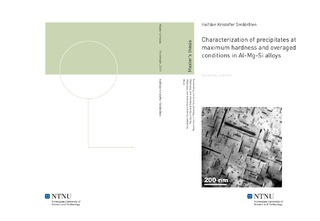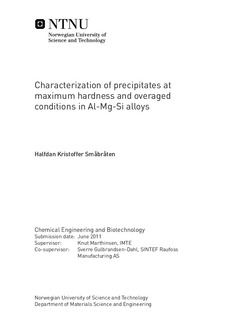| dc.contributor.advisor | Marthinsen, Knut | nb_NO |
| dc.contributor.advisor | Gulbrandsen-Dahl, Sverre | nb_NO |
| dc.contributor.author | Småbråten, Halfdan Kristoffer | nb_NO |
| dc.date.accessioned | 2014-12-19T13:25:49Z | |
| dc.date.available | 2014-12-19T13:25:49Z | |
| dc.date.created | 2012-04-20 | nb_NO |
| dc.date.issued | 2011 | nb_NO |
| dc.identifier | 517075 | nb_NO |
| dc.identifier | ntnudaim:6534 | nb_NO |
| dc.identifier.uri | http://hdl.handle.net/11250/248923 | |
| dc.description.abstract | A study of the influence of artificial ageing temperature on the precipitation behaviour in three distinct direct chill casted and extruded Al-Mg-Si alloys has been carried out. The total amount of alloying elements is approximately the same in these alloys, but the difference is the ratio between these elements. The master thesis is a continuation of the work reported in Characterization of precipitates at maximum hardness in Al-Mg-Si alloys which was written in connection to the course TMT4500 Materials Technology, Specialization Project. The primary objective of this work was to identify the value of maximum hardness, and at what time it is obtained for these alloys after they have been artificially aged, one set at 200 °C and another at 250 °C, i.e. six cases in total. The aim in the master thesis has been to investigate which type and relative amount of needle shaped precipitates that are present, and what size, number density and volume fraction that is responsible for these conditions by using transmission electron microscopy (TEM). In addition, all three alloys have been shown to obtain a local hardness maximum at overaged conditions in the 200 °C case. These conditions have also been analysed by comparing with an overaged condition for KK5 for an ageing time shorter than the one were the local maximum appears. Therefore, ten different conditions have been investigated in total.One sample has been selected from each case based on the hardness curves in the project work, and prepared for analysis in two different TEM instruments. A number of general trends between alloy composition, heat treatment, and the resulting microstructure and hardness that already have been reported, have been verified during the master thesis. The maximum hardness conditions after artificial ageing at 200 °C have been found to be quite different for KK5, KK6 and KK7 in terms of type and relative amount of precipitates, and precipitate size and number density. Artificial ageing at 250 °C has been observed to give very similar values of maximum hardness for the three alloys primarily due to the size and number density of the precipitates. The local maximum hardness peaks observed at overaged conditions after artificial ageing at 200 °C have been seen to be purely due to precipitate size and number density, but the reason for their appearance has not been clarified. The observed differences between the three alloys in each condition and the differences between the conditions themselves for each alloy have been seen to be reflected in both type and relative amount of precipitates, and precipitate size and number density. | nb_NO |
| dc.language | eng | nb_NO |
| dc.publisher | Institutt for materialteknologi | nb_NO |
| dc.subject | ntnudaim:6534 | no_NO |
| dc.subject | MTKJ Industriell kjemi og bioteknologi | no_NO |
| dc.subject | Materialutvikling og -bruk | no_NO |
| dc.title | Characterization of precipitates at maximum hardness and overaged conditions in Al-Mg-Si alloys | nb_NO |
| dc.type | Master thesis | nb_NO |
| dc.source.pagenumber | 145 | nb_NO |
| dc.contributor.department | Norges teknisk-naturvitenskapelige universitet, Fakultet for naturvitenskap og teknologi, Institutt for materialteknologi | nb_NO |

